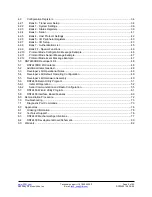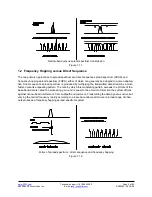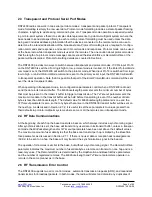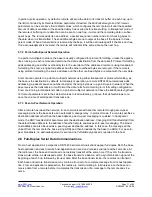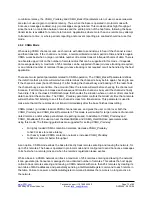
www.RFM.com
Technical s1.678.684.2000
Page 18 of 82
©2009 by RF Monolithics, Inc.
E-mail:
DNT2400 - 08/18/09
5. When operating in CSMA mode 1 with multiple remotes, the CSMA_RemtSlotSize and HopDura-
tion parameters are usually set to accommodate three times the number of data bytes in one
maximum size transmission, to allow time for more than one remote to attempt to transmit during
a single hop.
Figure 2.10.5.1
The DNT Throughput Calculator utility program is shown in Figure 2.10.5.1. Decimal data is entered by
default. Hexadecimal data can also be entered using a 0x prefix, as shown in the Hop Duration Counts
text box. When using the DNT Throughput Calculator, parameter coordination depends on the operating
mode of a DNT2400 network, as outlined below:
Polling (mode 0) - the user can set and must coordinate the RF data rate, hop duration, base slot size
and remote slot size. First, set the BaseSlotSize to accommodate the maximum number of data bytes in a
base transmission. Next, set the CSMA_RemtSlotSize to accommodate the maximum number data bytes
in a remote transmission. Use these slot sizes, the RF data rate and the maximum operating range (20
miles is the default) as inputs to the Calculator program to determine minimum valid HopDuration.
CSMA contention (mode 1) - the same procedure as for polling is used, except that the CSMA_
RemtSlotSize typically should be set at three times the maximum number of data bytes for point-to-
multipoint networks. The default values for CSMA pre-delay and back-off are assumed.
TDMA dynamic (mode 2) - this is the DNT2400’s default operating mode and the default settings are
optimized for point-to-point transparent operation. For other configurations the user must coordinate the
RF data rate, hop duration, base slot size and maximum number of remotes. Although the remote slot
size and remote slot time allocation are automatically set in mode 2, the user must predetermine these
values to assure a valid operating configuration. First, set the BaseSlotSize to accommodate the maxi-
mum number of data bytes in a base transmission. Next, determine the RemoteSlotSize required to
accommodate the maximum number of data bytes in a remote transmission. Use these slot sizes, the
maximum number of remotes that will be used in the network, the RF data rate and the maximum operat-
ing range as inputs to the Calculator to determine the minimum valid HopDuration time. Note that when
there are fewer remotes on the network than the maximum specified, the remotes will automatically be
configured with a bigger RemoteSlotSize parameter.

